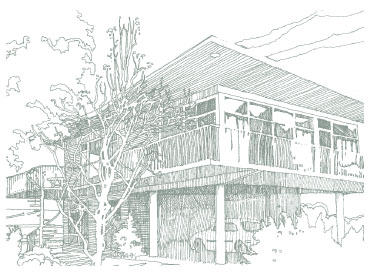
Existing Structures All existing buildings and structures contain embodied energy. Embodied energy is the energy consumed by all of the processes associated with the production of a building, including the manufacture of building materials, transportation and construction on site. The typical Victorian period house contains energy equivalent to 15,000 litres of petrol* - enough to send a car around the earth five times. It is more energy efficient to make minor modifications to an existing building than to replace it. Small modifications to heritage houses can make a big difference to your energy consumption. In altering your home be sure not to sacrifice its heritage significance and make improvements in a sensitive manner. |

|
Inside > insulate ceilings, walls and floors where possible and appropriate > insulate windows with ceiling-to-floor curtains > install door and window seals to eliminate draughts > ensure any new heated water pipe installations are insulated > open curtains to let light in during the day and close curtains to keep heat in at night in winter > light the house with low wattage light bulbs > in rooms with high ceilings, install ceiling fans to redistribute heat in winter and to increase summer comfort > don’t over-heat or over-cool your house: set thermostats for heating in winter to a maximum of 20 degrees and lower when sleeping, and for cooling in summer set to a minimum of 24 degrees > explore the possibility of installing a heat exchanger in the roof space > install water-saving fittings such as an AAA rated showerhead and a three or four and a half litre dual flush toilet |
Outside > use deciduous vegetation on the north side of your house to shade it during summer while letting the sun through in winter > use appropriate vegetation to reduce your exposure to east/west sun > consider installation of a rainwater tank and solar hot water > examine opportunities for concealed locations for rainwater storage |
New Structures or Extensions In general, it is preferable to extend at the rear of an existing structure, respecting its current style, rather than compromise the original design with alterations. Rather than replicating the style of the original house, design in a contemporary manner which is sympathetic to the original building. It is always easier to design for energy conservation at the beginning of a project than to try and modify later: when designing your additions be sure to consider energy issues at the planning stage. |
Inside > when buying a property, look for sites where living rooms face north > when building or extending, position living areas to allow for north facing windows > for additions, consider using sealed double glazed units for windows > in new structures include some smaller high windows that can be left open safely overnight to remove unwanted heat in summer > save energy and water by locating all hot water use areas as close to each other as possible; consider use of a ring main with a timer where outlets are far apart |
Outside > use eaves, a pergola and/ or verandahs to naturally cool or heat living rooms > install window shutters > consider use of a heat reflective paint on metal roofing to reduce the temperature inside the ceiling space |
Garden > plant deciduous vegetation to the north for summer shade and winter sunlight > when choosing plants consider the neighbourhood landscape and street plantings > retain existing mature trees and shrubs for natural shade and protection – plant new ones where more shade is needed > choose drought tolerant plants which do not require watering > mulch and use drip irrigation rather than spray irrigation where watering is necessary > install a grey water recycling system linked to your shower and washing machine - your garden could thrive even during a drought > use compost on the garden |
Reuse The reuse and recycling of building materials commonly saves about 95%* of embodied energy: reuse or recycle building materials wherever you can. If your home is within a Heritage Overlay or on the Victorian Heritage Register, you will most likely need a permit to do any building works. Consult with your local council or Heritage Victoria to find out the best way to undertake your works. Consult an architect, designer or builder on how to incorporate these and other energy-wise features in your home. |
|
Further Information Heritage Victoria is currently compiling a study on the quantity of embodied energy contained in a typical example of each of our housing styles. This study will be accompanied by recommendations on improving the energy efficiency of houses specific to that housing style. We will make this information available from our website from late 2009. For more information on heritage and sustainability, read Heritage Victoria’s Technical Leaflets: |
| For more detailed information, visit: |
| www.5starhouse.vic.gov.au |
| www.greenhouse.gov.au/yourhome/technical |
| www.sustainability.vic.gov.au |
| For water efficient devices, go to: |
| www.waterrating.gov.au |
| *Dr Selwyn Tucker, ‘Embodied Energy’, CSIRO, |
| www.cmit.csiro.au/brochures/tech/embodied/ |
